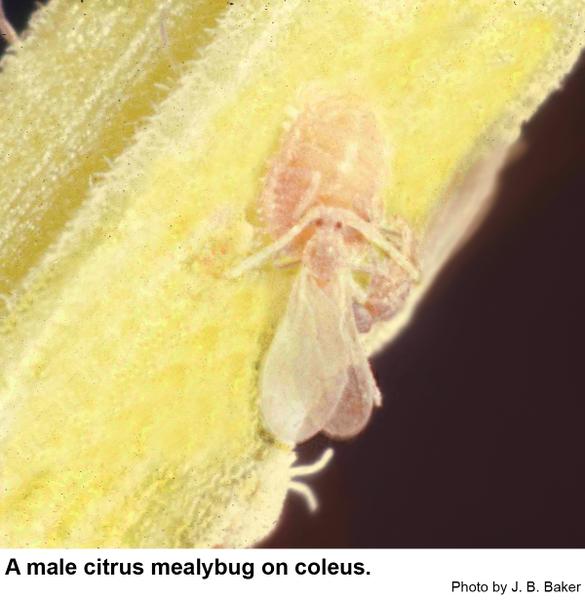Description and Biology
Because female citrus mealybugs, Planococcus citri, have no wings, they must crawl or be transported to the next host plant by ants, birds, or people. Small nymphs can be blown about. Females are oval in top view and are usually covered with a fluffy, white secretion. Sometimes they have a slightly darker line down the back. Males pupate in a fluffy cocoon of wax. Males are tiny insects with two wings, a slender, white "tail," and four eyes. After mating, each female lays 300 to 600 eggs in a dense, fluffy secretion called the egg sac or ovisac. Within a few days, new mealybugs (crawlers) hatch and begin to squirm out of the ovisac. After six to ten weeks, a new generation of adults is ready to continue the wheel of existence. Light infestations are easily overlooked because mealybugs tend to wedge into crevices on the host plant. As their numbers increase, citrus mealybugs of all sizes can be seen crawling around or feeding on all exposed plant surfaces where they tend to clump together. Outdoors, citrus mealybugs do not survive our winters here in North Carolina. Mealybugs suck out sap and excrete honeydew, a sweet sticky liquid. Citrus mealybugs lay eggs in a dense, waxy mass called the ovisac.
Host Plants
Citrus mealybugs have been collected from at least 27 host plant families. Many ornamental plants grown in greenhouses, homes, and gardens are susceptible to attack including begonia, coleus, amaryllis, cyclamen, and dahlia. Citrus mealybug has been collected on canna, narcissus, and tulip outdoors. The mealybugs, honeydew, male cocoons, and ovisacs disfigure infested plants. Not only that, but as the mealybugs feed, they inject their saliva into the plant. Some plants are very sensitive to citrus mealybug saliva, which causes stunting, wilting, or even dieback when large numbers of mealybugs are feeding.
Residential Recommendation
Citrus mealybugs are not easy to control. If only a few plants are infested, mealybugs can be removed with a cotton swab dipped in rubbing alcohol. The plant can then be washed with mild soapy water to remove residual wax left by the mealybugs (about 2% soap, not detergent). The plants must be observed closely for a few weeks and new mealybugs removed as they appear. Soaps labeled for use as insecticides for mealybug control on ornamental plants include Safer's, Citrusoap, and Olympic brands. These soaps are available from garden shops and plant centers. Insecticidal soaps are popular with some horticulturists because of their relative safety to people. Houseplant sprays and granular treatments are also available for home use. If labeled for mealybugs, they should give adequate control. Mealybug ovisacs complicate control measures because pesticides do not readily penetrate into the ovisac to kill the eggs. Consequently, plants infested with mealybugs probably should be treated at weekly intervals at least twice and probably three times for complete control. This allows time for eggs to hatch and the new mealybugs to emerge from the ovisacs. Orthene and imidacloprid are systemic insecticides that can be used for mealybug control by homeowners. With Orthene, it would be a good idea to treat plants outdoors as Orthene has a distinctive odor some find offensive.
References
- Insect and Related Pests of Flowers and Foliage Plants. Baker, J. R. ed. 1994 (revised). NC Cooperative Extension Service publication AG-136.
- Mealybugs. Frank, S. D. and J. R. Baker. 2010. Entomology Insect Notes, NC State Extension Publications.
- Common name: citrus mealybug, scientific name: Planococcus citri (Risso) (Insecta: Hemiptera: Pseudococcidae). Gill, H. K., G. Goyal, and J. L. Gillett-Kaufman. 2012. Featured Creatures, Entomology & Nematology, ACS/DPI, EDIS.
- Extension Plant Pathology Publications and Factsheets
- Horticultural Science Publications
- North Carolina Agricultural Chemicals Manual
For assistance with a specific problem, contact your local Cooperative Extension Center
This Factsheet has not been peer reviewed.
Publication date: Nov. 2, 2013
Reviewed/Revised: Aug. 10, 2023
Recommendations for the use of agricultural chemicals are included in this publication as a convenience to the reader. The use of brand names and any mention or listing of commercial products or services in this publication does not imply endorsement by NC State University or N.C. A&T State University nor discrimination against similar products or services not mentioned. Individuals who use agricultural chemicals are responsible for ensuring that the intended use complies with current regulations and conforms to the product label. Be sure to obtain current information about usage regulations and examine a current product label before applying any chemical. For assistance, contact your local N.C. Cooperative Extension county center.
N.C. Cooperative Extension prohibits discrimination and harassment regardless of age, color, disability, family and marital status, gender identity, national origin, political beliefs, race, religion, sex (including pregnancy), sexual orientation and veteran status.


